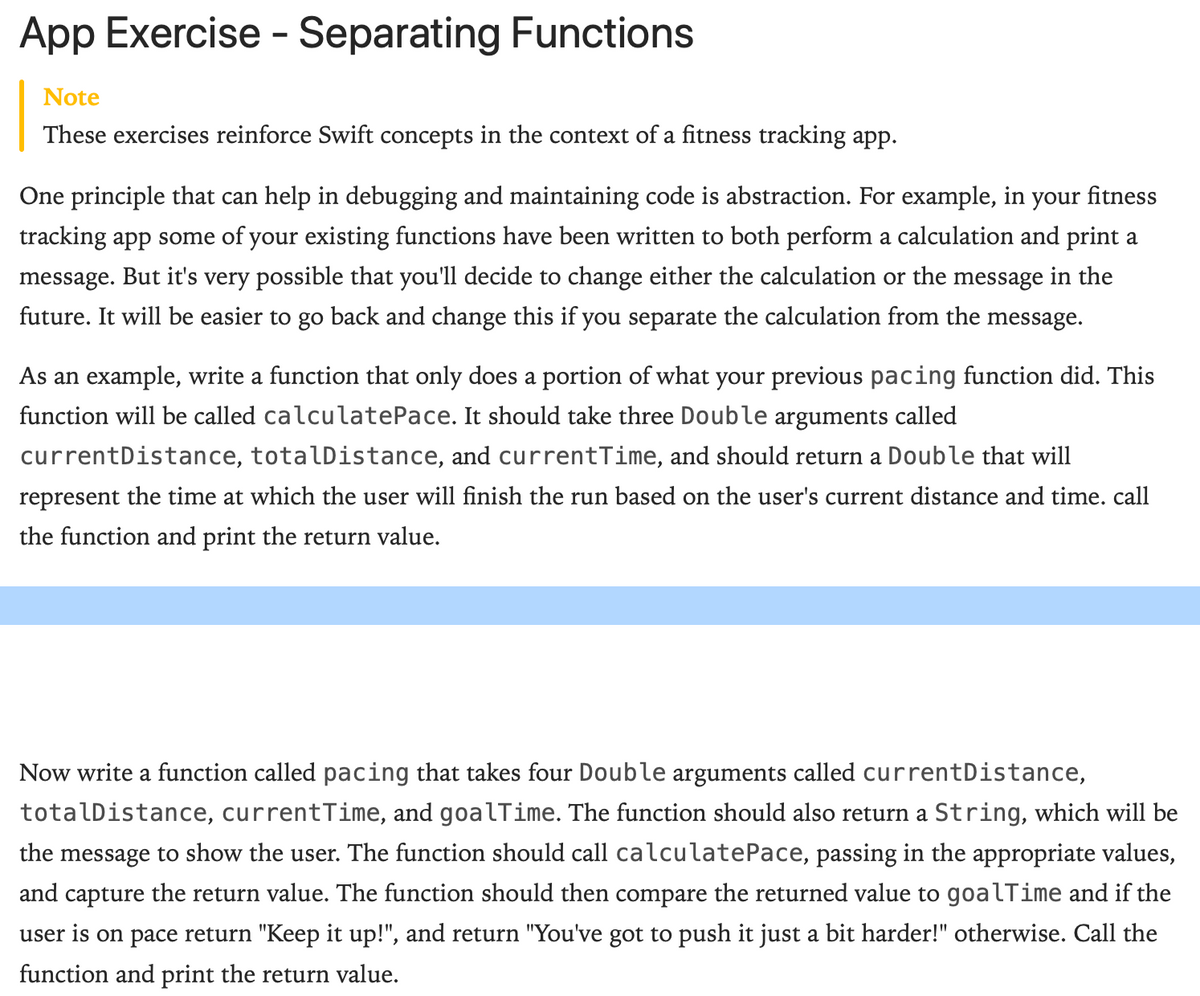One principle that can help in debugging and maintaining code is abstraction. For example, in your fitness tracking app some of your existing functions have been written to both perform a calculation and print a message. But it's very possible that you'll decide to change either the calculation or the message in the future. It will be easier to go back and change this if you separate the calculation from the message. As an example, write a function that only does a portion of what your previous pacing function did. This function will be called calculatePace. It should take three Double arguments called currentDistance, totalDistance, and currentTime, and should return a Double that will represent the time at which the user will finish the run based on the user's current distance and time. call the function and print the return value. Now write a function called pacing that takes four Double arguments called currentDistance, totalDistance, currentTime, and goalTime. The function should also return a String, which will be the message to show the user. The function should call calculatePace, passing in the appropriate values, and capture the return value. The function should then compare the returned value to goalTime and if the user is on pace return "Keep it up!", and return "You've got to push it just a bit harder!" otherwise. Call the function and print the return value.
One principle that can help in debugging and maintaining code is abstraction. For example, in your fitness tracking app some of your existing functions have been written to both perform a calculation and print a message. But it's very possible that you'll decide to change either the calculation or the message in the future. It will be easier to go back and change this if you separate the calculation from the message. As an example, write a function that only does a portion of what your previous pacing function did. This function will be called calculatePace. It should take three Double arguments called currentDistance, totalDistance, and currentTime, and should return a Double that will represent the time at which the user will finish the run based on the user's current distance and time. call the function and print the return value. Now write a function called pacing that takes four Double arguments called currentDistance, totalDistance, currentTime, and goalTime. The function should also return a String, which will be the message to show the user. The function should call calculatePace, passing in the appropriate values, and capture the return value. The function should then compare the returned value to goalTime and if the user is on pace return "Keep it up!", and return "You've got to push it just a bit harder!" otherwise. Call the function and print the return value.
Database System Concepts
7th Edition
ISBN:9780078022159
Author:Abraham Silberschatz Professor, Henry F. Korth, S. Sudarshan
Publisher:Abraham Silberschatz Professor, Henry F. Korth, S. Sudarshan
Chapter1: Introduction
Section: Chapter Questions
Problem 1PE
Related questions
Question
How do I solve this exercise using Swift code? 6 of 6.

Transcribed Image Text:App Exercise - Separating Functions
Note
These exercises reinforce Swift concepts in the context of a fitness tracking app.
One principle that can help in debugging and maintaining code is abstraction. For example, in your fitness
tracking app some of your existing functions have been written to both perform a calculation and print a
message. But it's very possible that you'll decide to change either the calculation or the message in the
future. It will be easier to go back and change this if you separate the calculation from the message.
As an example, write a function that only does a portion of what your previous pacing function did. This
function will be called calculatePace. It should take three Double arguments called
currentDistance, totalDistance, and currentTime, and should return a Double that will
represent the time at which the user will finish the run based on the user's current distance and time. call
the function and print the return value.
Now write a function called pacing that takes four Double arguments called currentDistance,
totalDistance, currentTime, and goalTime. The function should also return a String, which will be
the message to show the user. The function should call calculatePace, passing in the appropriate values,
and capture the return value. The function should then compare the returned value to goalTime and if the
user is on pace return "Keep it up!", and return "You've got to push it just a bit harder!" otherwise. Call the
function and print the return value.
Expert Solution
This question has been solved!
Explore an expertly crafted, step-by-step solution for a thorough understanding of key concepts.
This is a popular solution!
Trending now
This is a popular solution!
Step by step
Solved in 3 steps with 1 images

Knowledge Booster
Learn more about
Need a deep-dive on the concept behind this application? Look no further. Learn more about this topic, computer-science and related others by exploring similar questions and additional content below.Recommended textbooks for you

Database System Concepts
Computer Science
ISBN:
9780078022159
Author:
Abraham Silberschatz Professor, Henry F. Korth, S. Sudarshan
Publisher:
McGraw-Hill Education

Starting Out with Python (4th Edition)
Computer Science
ISBN:
9780134444321
Author:
Tony Gaddis
Publisher:
PEARSON

Digital Fundamentals (11th Edition)
Computer Science
ISBN:
9780132737968
Author:
Thomas L. Floyd
Publisher:
PEARSON

Database System Concepts
Computer Science
ISBN:
9780078022159
Author:
Abraham Silberschatz Professor, Henry F. Korth, S. Sudarshan
Publisher:
McGraw-Hill Education

Starting Out with Python (4th Edition)
Computer Science
ISBN:
9780134444321
Author:
Tony Gaddis
Publisher:
PEARSON

Digital Fundamentals (11th Edition)
Computer Science
ISBN:
9780132737968
Author:
Thomas L. Floyd
Publisher:
PEARSON

C How to Program (8th Edition)
Computer Science
ISBN:
9780133976892
Author:
Paul J. Deitel, Harvey Deitel
Publisher:
PEARSON

Database Systems: Design, Implementation, & Manag…
Computer Science
ISBN:
9781337627900
Author:
Carlos Coronel, Steven Morris
Publisher:
Cengage Learning

Programmable Logic Controllers
Computer Science
ISBN:
9780073373843
Author:
Frank D. Petruzella
Publisher:
McGraw-Hill Education